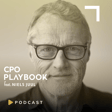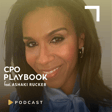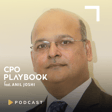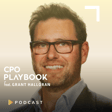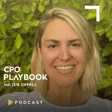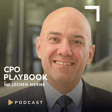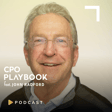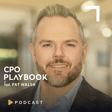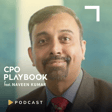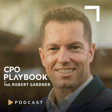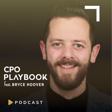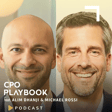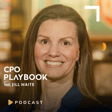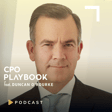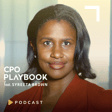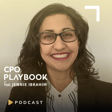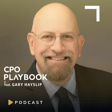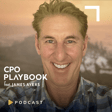Introduction to the CPO Playbook Podcast
00:00:05
Speaker
Hello, everyone. I'm Felicia Shakiba, and you're listening to the CPO Playbook Podcast. Join me and my guests as we feature insightful conversations with HR leaders, people scientists, and executives from diverse industries and functions, offering valuable perspectives on the future of work.
00:00:23
Speaker
Discover a unique outlook on navigating the complexities of the modern-day working world. Exploring innovative strategies in talent management and corporate culture from the chief people officer's perspective. Tune in to stay ahead of the game when it comes to all things people related.
Challenges of Scaling Companies Rapidly
00:00:44
Speaker
Some of the greatest challenges organizations face are during periods of explosive growth. Scaling a company at breakneck speed is a formidable task, and businesses experiencing rapid expansion often grapple with a critical conundrum.
00:01:00
Speaker
how to swiftly onboard a substantial workforce without compromising their unique culture and operational efficiency. In some cases, this entails hiring thousands of new employees within a single year. There's additional pressure when anticipating IPO readiness within a tight timeframe, an extra layer of complexity to the equation. Today, we explore these challenges in depth.
00:01:25
Speaker
and uncover the innovative strategies and operational excellence frameworks employed by Paper, a remote online tutoring solution for students, and San Francisco-based giant Airbnb, when they successfully navigated this turbulent terrain as the IPO in 2020.
00:01:48
Speaker
Q, welcome to the show. We're excited to have you here. Thanks for having me.
Insights from Paper and Airbnb on Expansion
00:01:52
Speaker
Q, to provide our listeners with some context, could you share your role and challenges you are faced with at Airbnb during the period of rapid growth and the role that you're in today?
00:02:02
Speaker
Yeah, I'll start with today. So I'm currently the Chief People Officer and Communications Officer at Paper, which is a series the education technology company with the mission to reduce the inequality gaps in public education in K through 12 in the US. And my scope ranges from all aspects of HR, including recruiting to internal communications, public relations and external communications as well.
00:02:26
Speaker
I've been at paper for about seven months. Prior to that, I was at Airbnb for almost five years, and I had a variety of roles there, but two of the more distinct roles are one was I was the global head of people operations, which included setting up an operational framework for our people function. And more recently, in the last year, I also was responsible for leading our Live and Work Anywhere Center of Excellence, which was Airbnb's future work program.
00:02:55
Speaker
And I would say the common theme across both of those in terms of challenges is how do you keep up with growth or shrinkage or reductions, whichever way you look at it, because at both organizations that I'm at right now, both have experienced tremendous growth and then tremendous corrections or reductions in force as well to make sure we keep up with the current state of the land.
Managing Workforce Changes Effectively
00:03:19
Speaker
Keeping up with the ebbs and flows, but it's not just hyper growth anymore. It's hyper growth and optimization on the other end as well. And then really trying to understand what your employees need so you can build something that's relatable and goes through from there.
00:03:33
Speaker
When trying to get headcount right, meaning rapid growth, rapid shrinkage, as you might refer to it as, walk me through the game plan, the goals, and how big is and was the PeopleOps team during time at Airbnb and at Paper Today.
00:03:52
Speaker
Yeah. So when I joined Airbnb in 2018, we were just shy of 3000 employees. So call it 2800 ish. And we were in a period of intense hyper growth and we reached almost 7,500 people. So roughly two and a half, three X in 11 months after I joined. So that was a period of extreme hyper growth. The people ops team, when I joined Airbnb was just two people, two fairly junior people.
00:04:20
Speaker
What that meant was there was no operational rigor and consistency in the people function, because when you don't have a people ops function, everyone is doing operational work. From HR business partners, trying to do entries into HRISs, to helping with leaves. And when it's not done in a streamlined way, it's not consistent and it's not efficient use of time for people that, for example, HRBPs want to and need to focus on the business.
00:04:46
Speaker
So Airbnb was, the first year was hypergrowth. That was 2018 to 2019, going right into 2020, around March of 2020, when the world kind of stopped on all of us. It unfortunately halted Airbnb's business significantly in Q2 of 2020 with travel.
00:05:03
Speaker
slowing down across the board. And that in turn led to our pretty big 25% reduction globally in May of 2020. So I was leading that process as well. And then I would say the few years after that, we went through the reduction 25% in May of 2020. And roughly six to seven months after that in December of 2020, we turned the business around and had a successful IPO.
00:05:31
Speaker
And the PeopleOps team, when I started, as I mentioned, was two. At this point, it was probably 25, 27 people globally, because we had operation in 30 countries as we grew. And then the last few years was really just setting up future work, incubating various programs that were typically not done by HR. And sometimes you got to kind of experiment and see what sticks.
00:05:55
Speaker
So that was Airbnb. It started off with two people. By the time I left, I think my kind of remote work and live and work anywhere team was about, I think 40 to 45 full-time employees and over a hundred vendors. So pretty large team.
00:06:09
Speaker
And yeah, that was the journey at Airbnb.
Airbnb's Recruitment and Onboarding Strategies
00:06:12
Speaker
It was the full cycle, if you will, from hyper growth to reduction, to turning around the business, to having a successful IPO, to trying to figure out what our future work stance was and coming out of that with a program that was very relatable, not just to our employees, but to the world at large as well in terms of adoption and impact on the business model.
00:06:32
Speaker
And you mentioned the need to hire thousands of new employees within a year. What were the key elements of your recruitment strategy and what measures did you put in place to ensure you found the right fit? So I would say as you grow in hyper growth, one of the things that we were very cognizant and intentional about was we wanted to grow quick, but we also wanted to put the right checks in place to make sure that we don't dilute
00:06:58
Speaker
alignment to our values and in turn our culture with future new hires. So one example of things that we did was we had in the interview process, we have two interviews that are internally referred to as core value interviews. You can think of just culture fit interviews and every single candidate at Airbnb who got hired would go through these two additional interviews for culture fit.
00:07:24
Speaker
With the kicker here being that if they did not pass those culture interviews, they were not hired. It was an intentional checkpoint. And the other important thing to note is the culture fit interviews were done by individuals that were not part of the function you were being recruited for.
00:07:41
Speaker
So for example, my culture fit interviews, I think it was one engineer and someone else in the product team, I believe. So it's not like they could talk to me about HR or people operations. They were truly trying to talk to me about the culture. So that's just one example of a checkpoint. The other checkpoint was more operationally.
00:07:59
Speaker
How did we build the tools and the systems? And to do this in a streamlined fashion, for example, when I joined the weekly start classes used to be seven to eight individuals a week. A year after I joined, the start classes were over a hundred a week. Right. So how do you do the backend operations in a streamlined way so that when a new hire shows up, they have the right system set up, they have the right
00:08:21
Speaker
equipment so that they can actually have a good onboarding experience. Because if you have the right onboarding experience, it sets you up for success, both for the organization and the individual involved. So I would say from culture fit interviews to core operational systems, streamlining were what got us to that point of making sure that we could try our best not to dilute the culture, per se.
00:08:46
Speaker
As you mentioned onboarding, we know that that's critical for new hires. And can you tell me a little bit more about that? Like what approaches or practices did you implement to enhance the onboarding experience?
00:08:59
Speaker
So one was from an infrastructure standpoint, as I just kind of talked about, so in terms of operations and systems. The second was we continued to double down on a high touch onboarding experience for all our employees, despite the fact that it was going to take a lot more work to do hundreds of employees versus eight or 10 employees. And we implemented things like in 2019, we would slide any new hire
00:09:28
Speaker
that started globally into our SF headquarters on a weekly or biweekly basis, so that there was a sense of unified onboarding experience and people got to experience what our headquarters was like and who we truly are.
00:09:44
Speaker
It comes down to not letting loose and thinking, okay, now you have a hundred people, it's going to take so much more work to do a high touch onboarding experience to saying, no, this is a process. This is a point in the employee journey that's onboarding that is very critical to the long-term success for both the individual and the organization. So we continue to double and triple down on that. And that's how we were able to balance.
00:10:11
Speaker
the orchestration of infrastructural support to make sure when people showed up they had what they needed and then balance that with the true onboarding or as we refer to it at Airbnb as our check-in experience, which was a week long. So everyone went through that whole week. No matter what level you were, you had to go through it. It was kind of in similar vein of the culture interviews in the sense where everyone had to do it and everyone would come down for that.
00:10:38
Speaker
And so the check-in would be being able to be at headquarters once or twice a week for the first week.
00:10:45
Speaker
No, the check-in would be a full week of your first week at HQ. And it was very intentionally programmed to have things like context for each of your different functional leaders would share what's top of mind or what are the priorities. It included things like, I remember when I started, our entire class went to the food bank in SF and packed fruits for the food bank.
00:11:09
Speaker
It was very individually programmed to make sure that the individual had a sense of where the business was, but then also the culture fit. And we did sprinkle moments. For example, there were one or two hours in the back half of the week in a day where they could connect with their team, be it virtually. So they had space to also do team level connection, but it was a full week of us onboarding check-in.
00:11:32
Speaker
I love how intentional those pieces are and to get the values right from the start. I think that's really important for the longevity of someone's time at any
Operational Efficiency During Growth
00:11:45
Speaker
company. I think that's really great. The data metrics.
00:11:49
Speaker
must play a significant role in tracking progress. So could you share specific KPIs or metrics that are instrumental in managing growth effectively? Yeah. So I think there are a couple of different metrics to track. One for us was
00:12:07
Speaker
We started tracking what were the error rates in our new hire process. What I mean by that, from the time a candidate would sign an offer to the time the candidate was onboarded in our systems, because there were two different systems, which is fairly common from a recruiting system standpoint and a core HRIS standpoint.
00:12:27
Speaker
We would have a bunch of errors that we historically, when I joined, if there were errors, they were just going into a black hole and you would find out about the errors when the employee was about to show up to work for their first day and they were not on the list, for example. Right. And then we would scramble to do it. So we started tracking and putting in tools and processes like reports and such to track our error rate. And we really pushed for like almost 99.9% no error success rate.
00:12:57
Speaker
We did achieve that. Occasionally there were misfires in terms of the integrations and stuff. So I would say on the candidate side, it's the error rate of the handshake from recruiting to the onboarding side and tracking that to make sure that we are making progress. On the kind of core operational front, I think a lot of SLAs that we put in place, we didn't really
00:13:20
Speaker
focus on SLAs as much in the first year, because I was really focused on building the foundation. What I mean by that is the way our people operations team or the way people were being serviced from a service delivery standpoint before I joined was we had email aliases for people to reach out to.
00:13:40
Speaker
When you have 3000 people and you have 10 different email aliases that they need to email, it ended up just becoming into kind of an email party, for lack of better words, right? Where you ask a question, someone else gets tagged and it keeps going on and on.
00:13:55
Speaker
So one of the things when I refer to as we wanted to set the foundation before we could track metrics, which I think is really critical, is we set up a ticketing tool in our first year, along with a knowledge base for people to self-serve the content they needed. And only if they could not find it at that point in time, they could reach out for help in a very streamlined manner through a backend ticketing tool that took care of all the
00:14:18
Speaker
Routing's between teams and the sausage making if you will that honestly the employee doesn't care about and doesn't even need to see they really just want a simplified answer for what they have asked. So once we set the foundation the metrics we tracked was holding ourselves to is in terms of responses to the tickets one of my initial learnings in my career was.
00:14:40
Speaker
really focusing too early on resolution times versus response times because the nature of people issues sometimes are they are complex and you need to peel into it. So it's hard to say we're going to close or resolve every single query or request in 24 hours versus we can commit to responding and making sure we are understanding what's needed. So service delivery metrics in terms of resolutions, how many routings are these going through just to get an answer?
00:15:10
Speaker
On the self-service front, I would say we also track metrics like if we are releasing a knowledge base for employees to self-serve content, are they being used? Is the adoption or the page views, are they being used at all? And tying that really to the overall service delivery metrics. So for example, if you have a lot of tickets about a particular topic, let's just pick something, example, retirement savings.
00:15:35
Speaker
There's a lot of tickets that are coming in and we're seeing that in our metrics when we look at ticket by various categories. Sometimes the answer may be that we're getting a lot of volume of these same questions for this example, retirement savings, because we don't have any self-service content.
00:15:52
Speaker
or sometimes the solution could be or the reality could be that we have content out there, but it's not tagged. So people can't find it. They don't even know it really exists. So really understanding the correlation between your metrics in the people's space, be it from service delivery of backend ticketing to front-end self-service is really critical. So we had metrics across the board, but I do lead with trying to figure out why are we even
00:16:22
Speaker
coming up with metrics, what will the metrics drive in terms of behaviors? Because early on in my career, I was perhaps too focused on metrics. And now I let the metrics follow the foundation and the why that makes sense. It does make sense. And I think that that was really insightful to talk about. It's not just about the resolution. It's about actually peeling away
00:16:42
Speaker
at a problem that may not get solved right away, but that action and being able to communicate well and quickly with a new hire, I think is really interesting. Or even just the employee base, right? Yep, exactly.
Supporting First-Time Managers
00:16:55
Speaker
So managing first time managers can be challenging during hyper growth phases as well. How did you ensure these individuals were equipped to lead effectively within the organization?
00:17:07
Speaker
So I would say for managing first-time employees is a challenge in hyper growth and ongoing, right? It's just the nature of being in a startup environment or a growth environment. I would say we tackled this on a couple of dimensions. One was having learning programs to help first, especially anyone who was moving into a people manager role would go through kind of the manager effectiveness course that we would call it. And pre-pandemic, these were in person.
00:17:34
Speaker
So we were making sure that people were engaged, they were focused post pandemic, obviously it moved to a virtual environment. But the highlight here is to help with manager effectiveness, there are, you know, let's just call it training programs. There's training resources. And I think most importantly, it's how leaders led by example.
00:17:54
Speaker
Right. So if I had a new, an individual, let's say that got promoted on my team to a manager for being there for the first time, it was how did I help them as their manager, set guidelines, things like what is your cadence of, are you doing one-on-ones with your team?
00:18:11
Speaker
Are you checking in on career conversations? Are you making sure that you are involved at the right level? So I would say aside from training programs, which are kind of table stakes in some ways, it's really how the leaders and the managers of the managers led by example. So for example, if I told my newly appointed manager that you should be doing one-on-ones and I never did it with them.
00:18:34
Speaker
it does not really stick right so i think leading by example so managers managers i guess in this example would be the key to success and then also recognizing where they might need support. Not just from an initial training perspective to set the baseline and leading by example but also,
00:18:53
Speaker
Some first time managers may struggle. We all have, I did when I was a first time manager, trying to understand what works well for me to stay abreast to all the things that are happening. So understanding where they might need help and supporting them on that. It could be talking to another manager and getting different perspectives on what works well for productivity for themselves as a manager. Cause there's no one size fits all to maybe recommending.
00:19:17
Speaker
training or conferences to go to network with like-minded peers so they can share how different people are driving manager effectiveness in a different way. So I think there's a few dimensions and we did all of them. And it's the same thing at paper as well. It's really driving into how do we lead by example, how do we provide the training mechanisms, but then also how do we provide ongoing support? Because really how you manage performance of your managers as a manager,
00:19:47
Speaker
can feed into manager effectiveness as well.
Leadership Advice: Aligning Employee and Business Goals
00:19:50
Speaker
A hundred percent. I think when you think about leading and all aspects of the business, the C-suite is always the biggest impact. It's like if you want your new managers to be successful, start at the top. So looking back on your experiences, what piece of advice would you give to leaders or organizations currently grappling with the challenges of wrapped growth?
00:20:11
Speaker
I would say the one piece of advice I would give leaders and organizations is really understanding what their employees want and marrying that up with what the business needs. Because the true magic really happens when you can align both of those together so that you can continue to evolve and grow as a business and help employees get there.
00:20:32
Speaker
The second one I would say is I have a quote that I read. It's not my quote, but I read this like a decade ago and it stuck with me and it goes something along the lines of, if you want to be liked, don't be a leader, go sell ice cream. And it really stuck with me because I think the advice I would give leaders is if you are trying to be liked by everyone, you will probably not succeed. You have to be the barrier to help people understand
00:20:57
Speaker
that it's not always what they want that you can give them. And honestly, that's how you drive and influence change and behaviors by not just blindly trying to give in. So that's what I would say. Don't strive to be liked 100. It's okay if you're not liked 100% of the time, because to drive change, it's hard to get to that state.
00:21:18
Speaker
Absolutely. I completely agree. And I think that I remember when I was working for a company, it was a hundred thousand employees and I had so many stakeholders and there were so many different parts of the business, but I knew that if I was trying to get everyone satisfied, I would fail. So I think you're spot on with that advice and I hope a lot of people hear it and carry it with them through their journey. So thank you for being here.
00:21:48
Speaker
Yeah, sure. Thank you for having me. It was a pleasure. That's Kew Hammurani, Chief People and Communications Officer at Paper and former Global Head of People Operations at Airbnb.
Podcast Conclusion and Future Engagement
00:22:07
Speaker
If you like today's podcast, we have more podcasts on innovative HR strategies, talent management, organizational culture, and more, and how to navigate the complexities of modern day HR. Find them at cpoplaybook.com slash podcasts or search CPO Playbook on Apple Podcasts, Spotify, or wherever you listen.
00:22:30
Speaker
Thanks for listening to the CPO Playbook Podcast. We'll be back with a new episode. Next time, I'm Felicia Shakiba. If you love CPO Playbook, the best thing you can do to support us is become a subscriber. You can do that at cpoplaybook.com slash podcast. That's cpoplaybook.com slash podcast. If there's an episode you loved, please share it with a friend.
00:22:57
Speaker
And if you have an idea you would like us to talk about or a guest you'd like to nominate, visit cpoplaybook.com slash contact us to suggest an idea.

